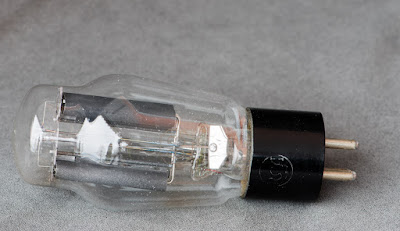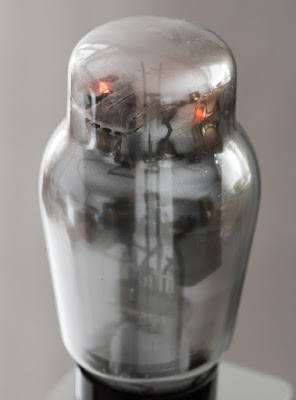Let's start 2017 with a tube presentation. I picked a rectifier for this month, not just an ordinary one but a full wave mercury vapour rectifier: The 83.
As a Full wave rectifier it has two plates and a common cathode. It is meant to be used with a power transformer with a center tap on the secondary.
 The 83 is directly heated, which means the filament is identical to the cathode and thus it only needs four pins as shown on the left. The two plates get connected to the high voltage secondary. The center tap of the high voltage secondary severs as ground. Rectified voltage output can be taken from either side of the filament or from a center tap on the filament winding. The filament of the 83 needs 5V and a hefty 3A. The 83 was developed for higher current demands. It can deliver up to 250mA. Besides the increased current handling capability the mercury vapour enables a low voltage drop of only 15V which is mostly constant and not impacted by current draw. This is beneficial in applications with varying current draw as for example in Class AB amplifiers. Maximum peak inverse voltage is 1400V. For all technical parameters see the RCA data sheet. The tube comes in a ST16 size glass bottle which is the same envelope as seen on a 2A3. As far as I am aware the 83 was never made in
The 83 is directly heated, which means the filament is identical to the cathode and thus it only needs four pins as shown on the left. The two plates get connected to the high voltage secondary. The center tap of the high voltage secondary severs as ground. Rectified voltage output can be taken from either side of the filament or from a center tap on the filament winding. The filament of the 83 needs 5V and a hefty 3A. The 83 was developed for higher current demands. It can deliver up to 250mA. Besides the increased current handling capability the mercury vapour enables a low voltage drop of only 15V which is mostly constant and not impacted by current draw. This is beneficial in applications with varying current draw as for example in Class AB amplifiers. Maximum peak inverse voltage is 1400V. For all technical parameters see the RCA data sheet. The tube comes in a ST16 size glass bottle which is the same envelope as seen on a 2A3. As far as I am aware the 83 was never made in globe shape glass, only ST shape. Unlike other mercury vapour tubes like the 866A or 816, the 83 can be mounted vertically as well as horizontally. It also does not need a pre heating of the filaments to vaporise the mercury before high voltage gets applied. But of course it will not hurt to treat it gently. One of the most well known uses of 83 rectifiers was in the TV-7 tube tester. This tube tester is also an example in which the tube is operated while mounted in horizontal position and no means of pre heating are applied. 83s were quite popular with amplifier builders during the 1990ies but seem to went out of fashion. I haven't seen any in an amp since a long time and I never used it myself. That's why I only have a limited stock of tubes to show. But maybe one day a 93 will find it's way on top of one of my amplifiers. Let's start with a 83 made by RCA:
globe shape glass, only ST shape. Unlike other mercury vapour tubes like the 866A or 816, the 83 can be mounted vertically as well as horizontally. It also does not need a pre heating of the filaments to vaporise the mercury before high voltage gets applied. But of course it will not hurt to treat it gently. One of the most well known uses of 83 rectifiers was in the TV-7 tube tester. This tube tester is also an example in which the tube is operated while mounted in horizontal position and no means of pre heating are applied. 83s were quite popular with amplifier builders during the 1990ies but seem to went out of fashion. I haven't seen any in an amp since a long time and I never used it myself. That's why I only have a limited stock of tubes to show. But maybe one day a 93 will find it's way on top of one of my amplifiers. Let's start with a 83 made by RCA:The small droplets of mercury are visible on the inside of the glass:
Here we see the little pouch which contained the mercury during manufacturing of the tube
Almost no getter visible in the tube
When filament voltage is applied without high voltage the mercury evaporates and condenses on the glass:
When high voltage is applied to the plates the ionised mercury gives of a blue glow
And the mercury completely evaporates and re condenses only at the base.
The blue glow is mainly visible inside the plates. It is not a constant glow but it flickers with the mains frequency (50Hz here in Europe). The glow lights up in each plate alternatively which can be seen in this short video clip:
The beating between the frame rate and mains frequency causes a visible flicker. In real life the flicker is too fast for the eye to notice.
Next we have some PhilipsECG JAN83 made for the military.
These were made in the 1980ies. Contrary to the RCA shown above they have a large getter deposit.
In my test set up which I built to show the glow these have a much fainter blue inside the plates:
Measurements showed that they exhibit a larger voltage drop than usual 83s. As with other late tube productions these also seemed to have suffered from poorer quality compared to tubes from the golden era.
Here are my most beautiful 83 tubes.
Made in Italy by Fivre.
Each of them carries a tax sticker
The top of the tube:
Base:
These boxes prove again that the Italians know a thing or two about style:
Nicely sealed boxes:
As in the RCA 83 they have a little pouch which held the mercury:
Close ups:
The Fivre 83 in operation:
The higher the current draw the more intense the blue glow:
Here we see how the mercury condenses mostly at the base, leaving the glass clear.
I hope you enjoyed this first Tube of the Month presentation of 2017!
Best regards
Thomas





































Nice post! I use a 83 in my funny version of your 801A-211 amplifier. Eveready made a globe version of the 83, the ER83 which was also available with mesh plates.
ReplyDeleteThanks for the info on the ER83! Never seen one!
DeleteHi Thomas,
ReplyDeletedo you conclude the possibility of horizontal mounting and the absence of necessary preheating from missing recommendations in the respective data sheets of doing so (or the treatment of the tube in that way in TV-7) or does one find this explicitly written somewhere?
Best regards,
Tom
Hi! I would always mount it vertically and do some pre heating
DeleteBR
Thomas
My BK 650 tube tester has an 83 mounted horizontally without preheat as well. I think it was a fairly common setup.
Delete